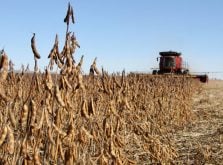The grain business in Brandon is going to rev up like a gas war, analysts say, as rival grain companies launch into a building spree in Manitoba to clinch their share of the market.
Five or six new facilities with a total capacity of more than 150,000 tonnes are slated for construction within a 100 kilometre radius of Manitoba’s second largest city.
It’s a price war farmers here anxiously await.
“I may never drive a truck into these new facilities but I’ll definitely be getting the benefits from them,” said Boissevain-area producer Allan Ransom.
Read Also

Pakistan reopens its doors to Canadian canola
Pakistan reopens its doors to Canadian canola after a three-year hiatus.
Kevin Archibald, who farms near Cartwright, said the newer, bigger, faster facilities will be able to cash in on lower rail rates, load cars more efficiently and that will mean better grain prices for farmers.
“I’m not sure how soon we will evolve to a commercial system but there’s no doubt it will come and producers who have these kinds of facilities in their regions are in a good position,” said the vice-president of the Western Canadian Wheat Growers Association.
Winnipeg agriculture consultant Dick Dawson said even if the grain collection system in southwestern Manitoba is being over-built, farmer have nothing to lose.
Besides Pioneer’s elevator in Killarney, which includes some farmer investment, the money won’t be coming from their pockets, he said. That’s the biggest difference between capital investment in the grain business today compared to decades ago when farmer-owned wheat pools dotted the Prairies with elevators.
“If they spend it stupidly, who cares? If it doesn’t work, it won’t be (farmers’) money going down the drain,” Dawson said.
“As a farmer, I think most might respond by being encouraged by the fact a group of smart-thinking, very careful business people think their area is worth investing this heavily in.”
But as the chain of announcements grows, one agriculture expert wonders if those same smart-thinking business people have started to squirm.
If not, they should, said Darryl Kraft, head of the University of Manitoba’s agriculture economics department.
“It is going to be an interesting situation to sit back and watch the grain handling business over the next five years with all the capital going in because clearly not all of the investors’ expectations are going to be reached,” Kraft said.
Business plans revealed most companies expect an inventory turnover of nearly 10 times per year. That’s 25 or 30 percent more than the existing facilities, which turn over about six times, he said. Most new terminals on the books also have a higher capacity.
“They can’t all do it,” Kraft said. “There’s just not enough grain.”
Don’t tell that to Andrew Paterson.
His Canadian-owned grain company is building an 11,000-tonne capacity elevator south of Brandon, near Killarney.
If there’s going to be a battle, Paterson said he’s ready.
“There’s no more grain there so it’s going to be a fight, there’s no doubt about it,” said the head of Paterson Grain.
The company’s record of doing business with farmers at its existing facilities in the region will give it the greatest advantage, Paterson said.
“The likes of Agpro and ConAgra have no market share so they’re going to have to take it away from somebody,” he said.
“They are experienced producers in that area and they’re not going to be easily conned.”
Paterson said while he’s not afraid of competition, American grain giant ConAgra might be the exception.
“It’s a huge company with a national demand for its product in the U.S.,” he said. “Even mighty Sask Wheat Pool stands to lose with that kind of competition.”
But Bob Sey, regional manager for Agpro Grain, which is building new 40,000-tonne facilities in Brandon and Boissevain, doesn’t sound worried.
Agpro is a subsidiary of Saskatchewan Wheat Pool.
“You’re always concerned that everybody wants a piece of the pie but the people who do the best job are the only ones who will survive down the line.”
Fill niche markets
He said Agpro plans to stay afloat by adding value to grain and contracting with farmers to target niche markets.
“These end users are looking for specific types of seed varieties and we’re in that ballgame,” Sey said.
Paterson said the company that spends the least amount on its facility, operates most efficiently and clinches the best markets will thrive.
“Sometimes bigger is not best because what happens is you lose touch with the business,” Paterson said.
Jim Weir, of Pioneer, said the company wouldn’t be building a 17,000-tonne capacity elevator near Killarney if it wasn’t certain of securing market share.
Welcomed to community
He said farmers and local economic development groups encouraged (Pioneer’s) participation in the market.
“We were getting some not so subtle reminders that there is a significant amount of business in that area,” Weir said.
Kraft said if some companies had foreseen the amount of competition moving into the area, they may have reached a different conclusion on whether to invest in the region.
“I would think if some of them were re-doing it today they may come to a different decision.”
But no one is likely to back out now, he added.
“The market share mantra has taken hold of these companies and that is carrying the argument of the day, not so much the financial aspect of doing business.”
Archibald said the Brandon region attracts grain companies because farmers in the area produce high quality cereals and oilseeds, there’s a good highway system and good access to the U.S. rail line, which meets the border at Bottinea two hours south of Brandon.
Brandon is also where the dividing line has settled, which determines whether export grain will be shipped east to Thunder Bay, Ont. or to terminals on the West Coast. It gives grain companies more flexibility, Kraft added.
“There’s more options when you’re dealing with customers for delivering at a greater rate if you have the options of the St. Lawrence or Minneapolis or the West Coast.”
However, it also makes the region one of the most expensive places to ship grain to port.
Ransom, whose farm is 50 km from the geographical centre of North America, said that’s the reason he’s moving into livestock.
“As a farmer trying to compete I have the highest transportation costs to off-shore markets,” he said.
Millions more coming
Up to $50 million could be invested in new and expanding hog and calf operations over the next five years, Archibald predicts.
“That’s going to take a major chunk out of what the grain companies need,” he said, adding there’s a handful of large hog barns already operating in the area and new projects proposed for Deloraine, Boissevain, Killarney and Hartney.
“How much barley that will take and the commitment of land means there will be less for oilseeds and wheat, which are the primary export crops.”
In the long run, over building could cost farmers money, said Alberta Wheat Pool president Alex Graham.
“Some believe farmers will be the winners but you need to realize the competition is not set by the elevator next door, but rather by the international marketplace,” Graham said.
“It may be good competition in the short term but in the long run all it does is add costs and that cost is ultimately embedded in tariffs and handling charges. and the farmer pays that bill.”














